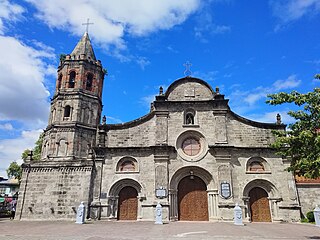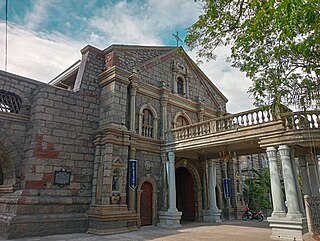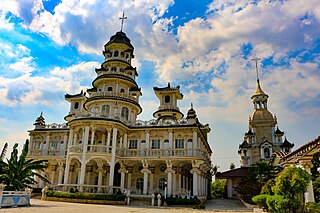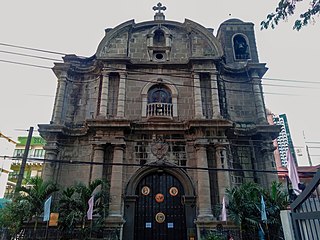
Bulacan, officially the Province of Bulacan ,(Kapampangan: Lalawigan ning Bulacan), is a province in the Philippines located in the Central Luzon region. Its capital is the city of Malolos. Bulacan was established on August 15, 1578, and part of the Metro Luzon Urban Beltway Super Region.

Quezon City, also known as the City of Quezon and Q.C., is the most populous city in the Philippines. According to the 2020 census, it has a population of 2,960,048 people. It was founded on October 12, 1939, and was named after Manuel L. Quezon, the second president of the Philippines.

San Jose del Monte, officially the City of San Jose del Monte, is a 1st class component city in the province of Bulacan, Philippines. According to the 2020 census, it has a population of 651,813 people, making it the largest local government unit within the province of Bulacan and Central Luzon, and the 18th most populated city in the Philippines.

Meycauayan, officially the City of Meycauayan, is a 1st class component city in the province of Bulacan, Philippines. According to the 2020 census, it has a population of 225,673 people. It is one of the oldest towns in the province.

The Saint Francis of Assisi Parish Church, commonly known as the Meycauayan Church or Simbahan sa Bayan, is a Roman Catholic church located in Meycauayan, Bulacan Philippines. It is one of the oldest parishes in Bulacan which even predates the Malolos Cathedral established in 1580 and the Barasoain Church established in 1859. It is also the province's largest parish with an estimated population of about 80,000 parishioners. The church is the seat of the vicariate of St. Francis of Assisi in the Diocese of Malolos.

Bulakan, officially the Municipality of Bulakan, is a 1st class municipality in the province of Bulacan, Philippines. According to the 2020 census, it has a population of 81,232 people.

Bocaue, officially the Municipality of Bocaue, is a 1st class municipality in the province of Bulacan, Philippines. According to the 2020 census, it has a population of 141,412 people.

Santa Mesa is a district in Manila, Philippines. It is surrounded by the Pasig River on the southwestern side, and by the San Juan River on its southern and eastern side. Land borders include the districts of San Miguel to the west and Sampaloc to the north; and to the northeast is Quezon City.

Paco, formerly known as Dilao, is a district of Manila, Philippines located south of the Pasig River, and San Miguel, west of Santa Ana, southwest of Pandacan, north of Malate, northwest of San Andres Bukid, and east of Ermita. According to the 2020 census, it has a population of 79,839 people.

Marilao, officially the Municipality of Marilao, is a 1st class urban municipality in the province of Bulacan, Philippines. According to the 2020 census, it has a population of 254,453 people. It is 22 kilometers (14 mi) from Manila and 23 kilometers (14 mi) from the provincial capital Malolos City.

The Roman Catholic Diocese of Cubao is a diocese of the western Latin Church of the Catholic Church in district of Cubao in Quezon City, in northern Metro Manila, Philippines. The diocese was created by Pope John Paul II on June 28, 2003 from the ecclesiastical district of Cubao of the Roman Catholic Archdiocese of Manila. It was canonically erected on August 28, 2003, with the installation of Honesto Flores Ongtioco as the first Bishop of Cubao. The Blessed Virgin Mary, under the title Immaculate Conception, is the principal patroness of the diocese.

The National Historical Commission of the Philippines is a government agency of the Philippines. Its mission is "the promotion of Philippine history and cultural heritage through research, dissemination, conservation, sites management and heraldry works." As such, it "aims to inculcate awareness and appreciation of the noble deeds and ideals of our heroes and other illustrious Filipinos, to instill pride in the Filipino people and to rekindle the Filipino spirit through the lessons of history."

Punturin is one of the 33 barangays that comprises the City of Valenzuela, Philippines. It is a mix of industrial and residential areas like its neighboring barangays of Bignay and Lawang Bato.

Novaliches Cathedral, canonically recognized as the Cathedral-Shrine and Parish of the Good Shepherd, is a Roman Catholic church located along Regalado Avenue in Barangay Fairview, Quezon City in the Philippines. It is the seat of the Diocese of Novaliches. It was established on August 5, 1975 by Manila Archbishop, Jaime Lachica Sin, who designated Fidelis Ruben Limcaco as the church's first parish priest.

The San Pedro Macati Church, also known as Saints Peter and Paul Parish, or Makati Church is a Roman Catholic church located in Makati Poblacion, the oldest part of Makati and for that reason, the cultural and heritage barangay of Makati, Philippines. In front of the church facade is Plaza Cristo Rey, which was formerly the San Pedro de Macati Cemetery. The Poblacion Church is a government-recognized cultural property based on the official list provided by the National Historical Commission of the Philippines. After 394 years, the church was re-dedicated; the first dedication happened in 1620 when it became a parish church, the next after the reconstruction of the facade in 1796 and finally again, on January 30, 2015. The dedication was led by Cardinal Luis Antonio Tagle, Archbishop of Manila, con-celebrated by Pedro Gerardo O. Santos, the then-parish priest, bishops, and priests.

Meycauayan station is a former railway station located on the North Main Line in Bulacan, Philippines. The station was once part of the line until its discontinuation in 1988. It is currently being rebuilt as part of the first phase of the North–South Commuter Railway. The old station will also be preserved.
Barangay BF Homes Caloocan or Barangay 169 is a barangay of Caloocan, Metro Manila, Philippines. The barangay is known for having jurisdiction of the larger portions of the Banco Filipino-developed real estate projects in Northern Manila, and is considered the most affluent barangay in Caloocan.
















